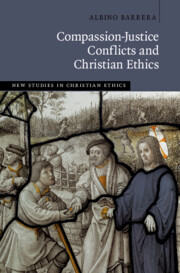127 results
Immanuel Kant’s Inheritance: Race in his Early Lectures on Physical Geography
-
- Journal:
- Kantian Review , First View
- Published online by Cambridge University Press:
- 10 March 2025, pp. 1-18
-
- Article
- Export citation
13 - Liturgical Philosophy of Religion
- from Part IV - Forms and Functions of Worship
-
-
- Book:
- The Philosophy of Worship
- Published online:
- 09 January 2025
- Print publication:
- 23 January 2025, pp 229-254
-
- Chapter
- Export citation
6 - Classical Humanism and Aesthetics
- from Part II - Autonomy and Teleocracy
-
- Book:
- Remaking the World
- Published online:
- 29 November 2024
- Print publication:
- 19 December 2024, pp 111-129
-
- Chapter
- Export citation
From radical evil to constitutive moral luck in Kant’s Religion
-
- Journal:
- Religious Studies , First View
- Published online by Cambridge University Press:
- 16 December 2024, pp. 1-11
-
- Article
-
- You have access
- Open access
- HTML
- Export citation
Chapter 1 - The ‘Vico-Effect’
-
- Book:
- Hegel and Italian Political Thought
- Published online:
- 11 December 2024
- Print publication:
- 05 December 2024, pp 31-71
-
- Chapter
- Export citation
5 - Rights, Property, and Politics
- from Part I - A Revolution in Rights?
-
-
- Book:
- The Cambridge History of Rights
- Published online:
- 22 January 2025
- Print publication:
- 28 November 2024, pp 114-139
-
- Chapter
- Export citation
Chapter 1 - Burke and Kant on Color and Inheritance
-
-
- Book:
- The Cambridge Companion to Romanticism and Race
- Published online:
- 21 November 2024
- Print publication:
- 28 November 2024, pp 7-21
-
- Chapter
- Export citation
1 - Introduction
-
- Book:
- The Theological Imagination
- Published online:
- 09 November 2024
- Print publication:
- 07 November 2024, pp 1-36
-
- Chapter
-
- You have access
- HTML
- Export citation
Myth 14 - That Darwin’s Critics Such as Owen Were Prejudiced and Had No Scientific Arguments
-
-
- Book:
- Darwin Mythology
- Published online:
- 30 May 2024
- Print publication:
- 06 June 2024, pp 159-170
-
- Chapter
- Export citation
Chapter 11 - Wagner, Schopenhauer, and the World as a Phantasmagoria
- from II - People
-
-
- Book:
- Wagner in Context
- Published online:
- 14 March 2024
- Print publication:
- 14 March 2024, pp 113-121
-
- Chapter
- Export citation
6 - The Legitimacy Thesis
- from Part II - Stability, Legitimacy, and Democracy
-
- Book:
- Statehood as Political Community
- Published online:
- 15 February 2024
- Print publication:
- 22 February 2024, pp 169-197
-
- Chapter
- Export citation
The Effect of Rousseau on Kant’s Resolution of the Antinomy of Practical Reason
-
- Journal:
- Kantian Review / Volume 28 / Issue 4 / December 2023
- Published online by Cambridge University Press:
- 16 November 2023, pp. 519-536
- Print publication:
- December 2023
-
- Article
- Export citation
12 - Seeking Enlightenment in Mozart’s Magic Flute
- from Part III - Approaches and Perspectives
-
-
- Book:
- The Cambridge Companion to <i>The Magic Flute</i>
- Published online:
- 24 November 2023
- Print publication:
- 02 November 2023, pp 187-199
-
- Chapter
- Export citation

Compassion-Justice Conflicts and Christian Ethics
-
- Published online:
- 19 October 2023
- Print publication:
- 02 November 2023
Between ‘Indubitably Certain’ and ‘Quite Detrimental’ to Philosophy: Kant on the Guise of the Good Thesis
-
- Journal:
- Kantian Review / Volume 28 / Issue 4 / December 2023
- Published online by Cambridge University Press:
- 16 October 2023, pp. 537-553
- Print publication:
- December 2023
-
- Article
-
- You have access
- Open access
- HTML
- Export citation
Chapter 9 - Film Scripts
- from Part II - The Literary Works
-
-
- Book:
- W. G. Sebald in Context
- Published online:
- 24 August 2023
- Print publication:
- 07 September 2023, pp 76-84
-
- Chapter
- Export citation
10 - Kant on History, or Theodicy for Mortal Gods
-
-
- Book:
- Time, History, and Political Thought
- Published online:
- 08 June 2023
- Print publication:
- 22 June 2023, pp 216-236
-
- Chapter
- Export citation
Chapter 6 - Neo-Kantianism and Moral Education
- from Part I - Historical Insights for Contemporary Moral Education
-
-
- Book:
- Moral Education in the 21st Century
- Published online:
- 01 June 2023
- Print publication:
- 15 June 2023, pp 94-112
-
- Chapter
- Export citation
Dignity, Dementia and Death
-
- Journal:
- Kantian Review / Volume 28 / Issue 2 / June 2023
- Published online by Cambridge University Press:
- 30 March 2023, pp. 221-237
- Print publication:
- June 2023
-
- Article
-
- You have access
- Open access
- HTML
- Export citation
Chapter 8 - Kant and the Genesis of Empiricism
- from Part III - From Experimental Philosophy to Empiricism
-
- Book:
- Experimental Philosophy and the Origins of Empiricism
- Published online:
- 17 February 2023
- Print publication:
- 23 February 2023, pp 234-257
-
- Chapter
- Export citation


